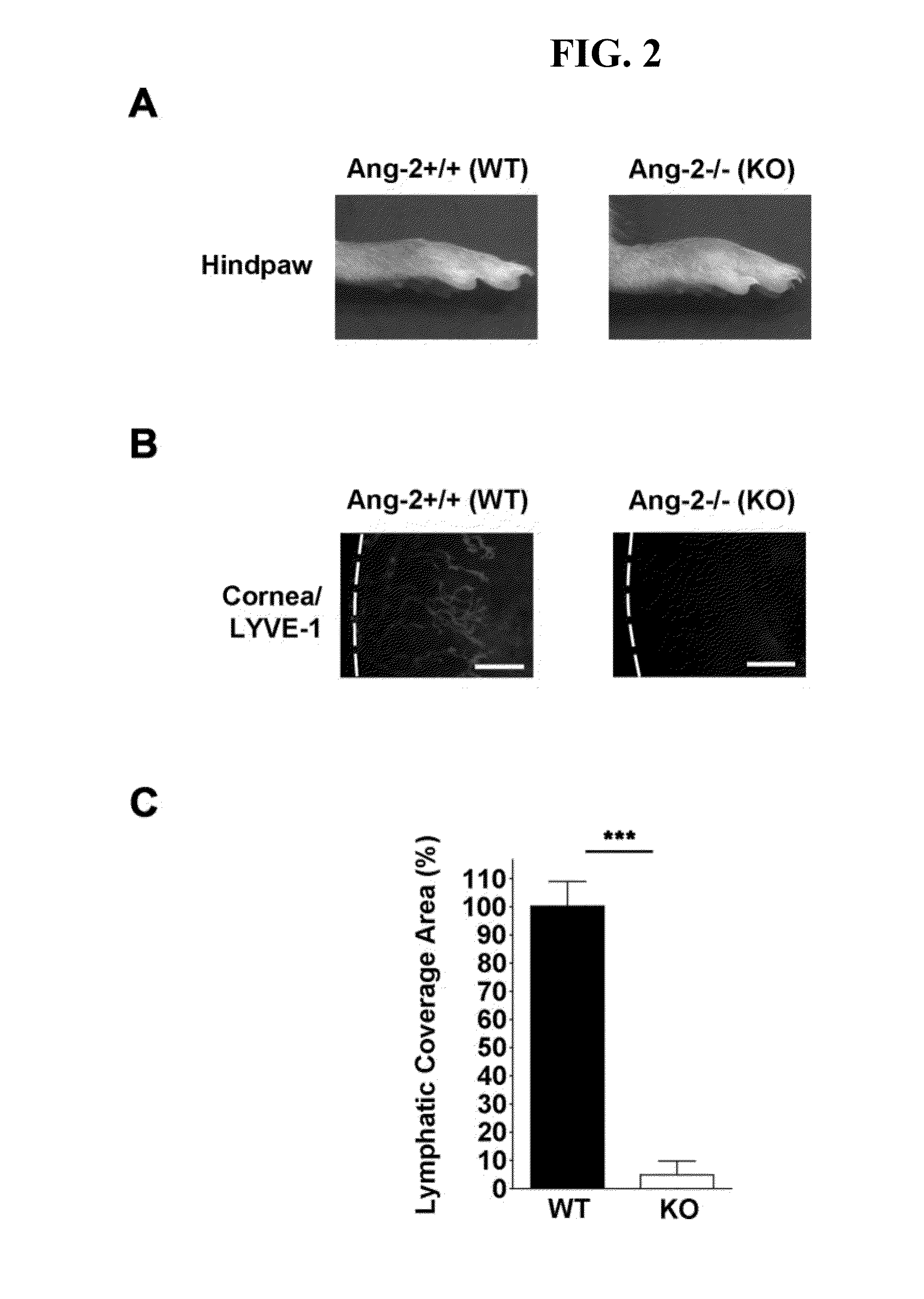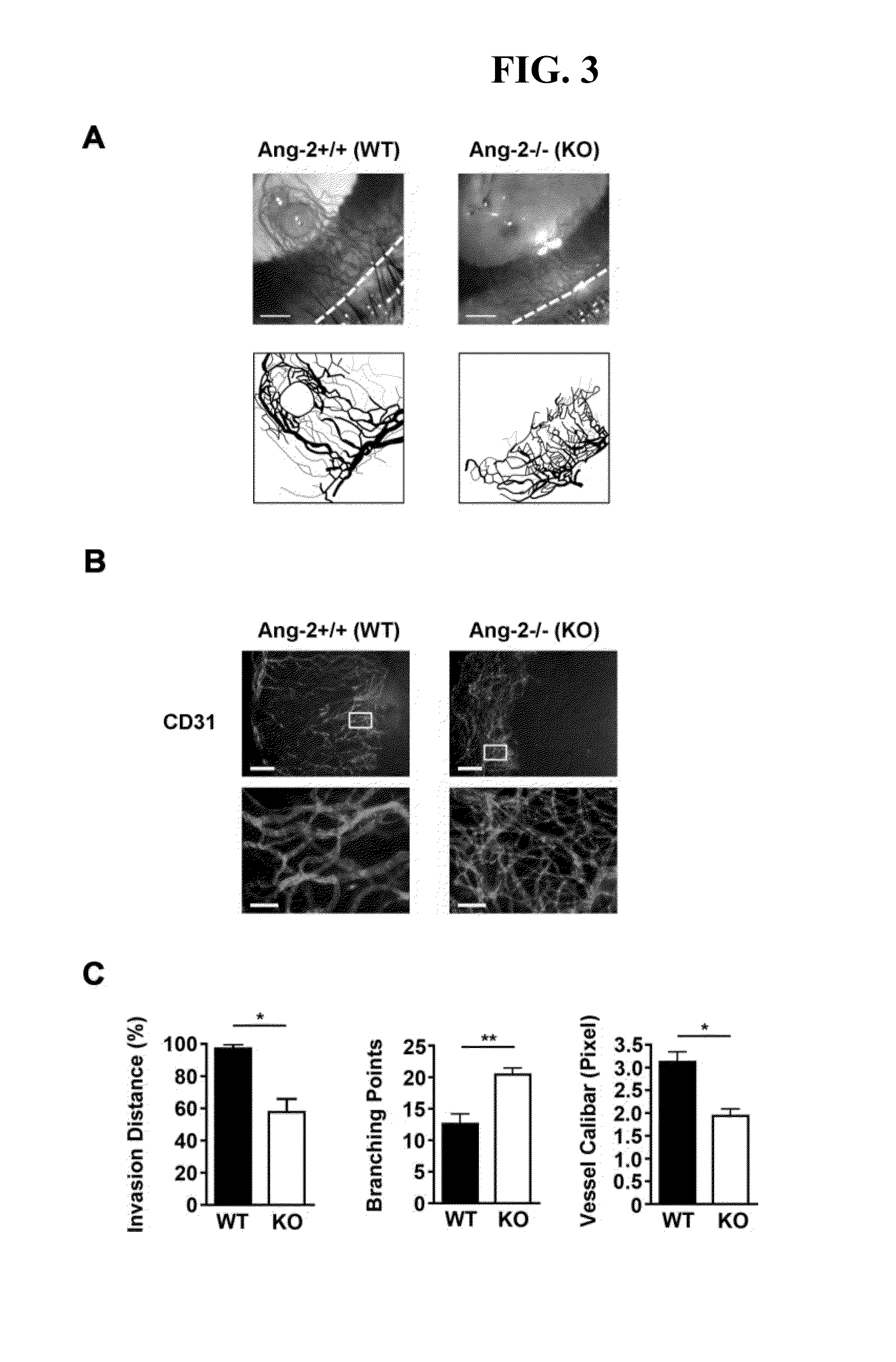Methods of modulating lymphangiogenesis, e.g., to treat corneal transplant rejection, in a subject
a technology of lymphangiogenesis and modulation method, which is applied in the field of modulating lymphangiogenesis, can solve the problems of inability to form lymphatic vessels, inability to demonstrate endogenous compensation of ang-2 stimulation by higher ang-1 expression within the tissue, and largely unknown specific roles of ang-2 in pathologic lymphatic processes. , to achieve the effect of improving graft survival, reducing antigen presenting cell function, and reducing the occurrence of lymphangiogenesis
- Summary
- Abstract
- Description
- Claims
- Application Information
AI Technical Summary
Benefits of technology
Problems solved by technology
Method used
Image
Examples
example 1
Role of Angiopoietin-2 in Corneal Lymphangiogenesis
[0191]Methods.
[0192]Standard suture placement model was used to study Ang-2 expression in inflamed cornea, and corneal inflammatory lymphangiogenesis (LG) and hemangiogenesis (HG) responses in Ang-2 knockout mice. Moreover, human skin lymphatic endothelial cell (LEC) culture system was used to examine the effect of Ang-2 gene knockdown on LEC functions using small interfering RNAs (siRNAs). The effect of siRNA treatment on corneal LG was also assessed in vivo.
[0193]Results.
[0194]Angiopoietin-2 was expressed on lymphatic vessels and macrophages in inflamed cornea. While corneal LG response was abolished in Ang-2 knockout mice, the HG response was also suppressed but to a lesser degree with disorganized patterning. Moreover, anti-Ang-2 treatment inhibited LEC proliferation and capillary tube formation in vitro and corneal LG in vivo.
CONCLUSIONS
[0195]Angiopoietin-2 is critically involved in lymphatic processes in vivo and in vitro in d...
example 2
[0244]Anti-Ang-2 antibody treatment suppresses transplantation-induced corneal lymphangiogenesis and donor derived cell trafficking (i.e., antigen presenting cell trafficking) to draining lymph nodes after transplantation and promotes corneal graft survival (FIG. 6). Transplantation experiments were performed in normal mouse corneas (i.e., low risk of transplant rejection) and the in vivo effect of systemic administration of anti-Ang-2 antibody (Eli Lilly) was evaluated. Panel A: whole mount corneal images showing reduced lymphatic vessels (green) in recipient cornea in the treatment group. Panel B: flow cytometry analysis showing reduced antigen presenting cell trafficking to recipient draining lymph nodes in the treatment group. These results provide additional data (panel B) showing that anti-Ang-2 antibody treatment reduces or inhibits antigen presenting cell trafficking to recipient draining lymph nodes, an important aspect of immune response to foreign antigens. Panel C: Kapla...
embodiments
[0247]Aspects of the present disclosure include a method of reducing the occurrence of lymphangiogenesis in a corneal transplant subject. In some embodiments, the method comprises administering to the subject an amount of an Ang-2 antagonist effective to reduce the occurrence of lymphangiogenesis in the subject. In some cases, the method is a method of improving graft survival in the subject. In some cases, the method is a method of reducing antigen presenting cell trafficking to draining lymph nodes. In certain embodiments, the subject has a high risk of corneal transplant rejection. In certain embodiments, the subject has an inflamed and vascularized graft bed. In certain embodiments, the subject has a low risk of corneal transplant rejection. In certain embodiments, the subject has an un-inflamed and avascular graft bed.
[0248]In some embodiments, the Ang-2 antagonist comprises a specific binding member that specifically binds to Ang-2. In certain embodiments, the Ang-2 antagonist...
PUM
| Property | Measurement | Unit |
|---|---|---|
| dissociation constant | aaaaa | aaaaa |
| dissociation constant | aaaaa | aaaaa |
| dissociation constant | aaaaa | aaaaa |
Abstract
Description
Claims
Application Information
 Login to View More
Login to View More - R&D
- Intellectual Property
- Life Sciences
- Materials
- Tech Scout
- Unparalleled Data Quality
- Higher Quality Content
- 60% Fewer Hallucinations
Browse by: Latest US Patents, China's latest patents, Technical Efficacy Thesaurus, Application Domain, Technology Topic, Popular Technical Reports.
© 2025 PatSnap. All rights reserved.Legal|Privacy policy|Modern Slavery Act Transparency Statement|Sitemap|About US| Contact US: help@patsnap.com



